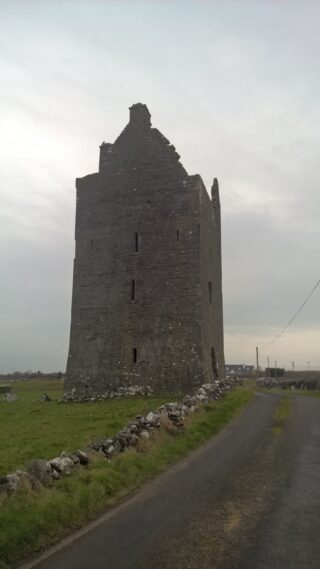Notice
Drumharsna Castle is a state-owned National Monument in the care of the Office of Public Works
*For External Viewing Only, Internal Access is Not Permitted*
WARNING: It should be noted that these sites are unguided and a level of care and caution should be maintained during all stages of your visit. The Office Of Public Works (OPW) will not be held responsible for any damages, injuries, or losses that occur
Drumharsna Castle
Located 5 kilometres (3.11 miles) south west of the village of Ardrahan, Co. Galway, this solid though formidably bleak five-story early-to-mid-16th-century tower house was built by the Anglo-Norman Kilkelly (McGillakelly) family, and was later owned by Shane Ballagh, of the O’Shaughnessy family, who was granted the castle and lands in 1574 by Queen Elizabeth I of England. In the early 18th century that castle came into the possession of the French family.
Originally protected by a bawn, or walled enclosure, the tower was designed as a defensive fortification, with an arched north eastern entryway, thick walls and tall narrow windows on each floor. The inside storeys are connected by a spiral staircase in the south east corner and the castle also contains several mural passageways. The second and fourth storeys are vaulted and the fifth floor is made up of an attic of a later period, of which there is one remaining gable-ended wall, and of battlements with a machicolation, or “murder hole”, strategically positioned above the ground-floor entrance for throwing large stones or pouring boiling water on would-be attackers.
The castle was occupied right up to the early years of the 20th century, with various alterations being made to its internal structure, including the addition of fireplaces and chimneys. Although most of the internal floorings have gone, the corbels that supported them and the ceilings can still be seen. During the Irish War of Independence (1919 -1921), Drumharsna was used by the Auxiliary Division of the Royal Irish Constabulary, as an interrogation centre for Irish republican rebels and their civilian sympathisers.
The castle was the scene of one of the most gruesome killings of that conflict when, on 26th November 1920, two members of the Irish Republican Army (IRA), brothers Patrick and Harry Loughnane were brought here for interrogation. Nine days later their mutilated, burnt and disfigured bodies were found hidden in a pond 5 kilometres north of Ardrahan. The brothers were laid to rest at Shanglish Cemetery, in Gort, Co. Galway. Full details of the incident can be found in the Bureau Of Military History collection of the Irish Military Archives at: www.militaryarchives.ie
Visit Historic Environment Viewer for more information on Drumharsna Castle
Protect our Past - Click here to read about the importance of protecting our country’s unique heritage sites
This national monument is protected in accordance with the National Monuments Acts 1930 to 2014
Gallery
Nearby sites to visit
Aughnanure Castle
A historical gem in the heart of Connemara
Approx. 42.0 km from Drumharsna Castle
Ionad Cultúrtha an Phiarsaigh Conamara- Pearse’s Cottage and Visitor Centre
A cottage steeped in revolutionary history and Gaelic culture
Approx. 58.3 km from Drumharsna Castle
Clonmacnoise Monastic Site
A spectacular monastery on the banks of the river Shannon
Approx. 60.5 km from Drumharsna Castle




